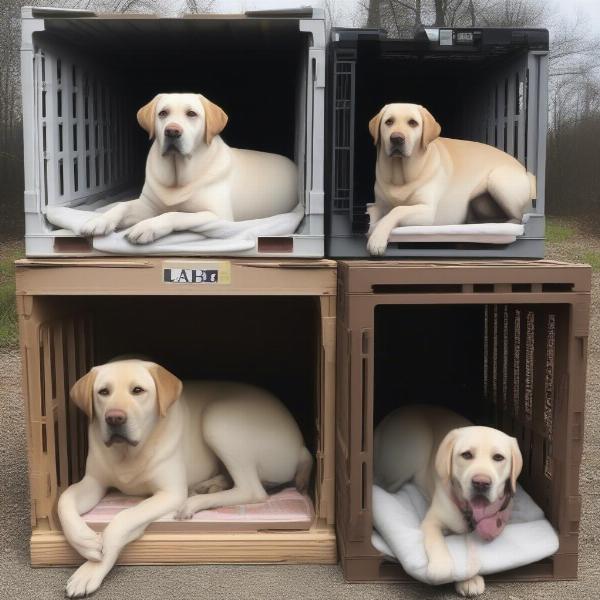Getting a dog crate for your Labrador Retriever is a big decision. It’s more than just a place to sleep; a properly sized and introduced crate can become a safe haven, a helpful tool for housetraining, and a comfortable den for your furry friend. This guide will help you navigate the world of dog crates for Labs, covering everything from size selection to crate training tips.
Understanding Your Lab’s Needs
Before diving into crate options, consider your Lab’s size and temperament. Labs are generally medium to large-sized dogs, known for their energetic and playful nature. A crate that’s too small will restrict their movement and make them uncomfortable, while one that’s too large can defeat the purpose of housetraining.
Dog Crate Sizes for Labs: Finding the Perfect Fit
So, what size dog crate for a Lab? A good rule of thumb is to choose a crate that allows your Lab to stand up comfortably, turn around, and lie down stretched out. For an adult Lab, this typically translates to a 42-inch crate. However, if you have a particularly large or small Lab, you may need to adjust accordingly. Puppies, of course, will need a smaller crate initially, and you can use dividers to adjust the space as they grow.
 Labrador Retriever in Different Crate Sizes
Labrador Retriever in Different Crate Sizes
Different Types of Dog Crates
Several types of dog crates are available, each with its own pros and cons. Wire crates offer good ventilation and visibility, plastic crates are lightweight and portable, and heavy-duty crates are ideal for strong chewers or anxious dogs. Consider your Lab’s personality and your lifestyle when making your selection. A travel crate can also be very useful if you are planning on traveling with your dog.
Crate Training Your Labrador: Tips and Tricks
Introducing your Lab to their crate should be a positive and gradual process. Start by making the crate a comfortable and inviting space with soft bedding and a favorite toy. Encourage your Lab to enter the crate on their own with treats and praise. Never force them inside. Gradually increase the time your Lab spends in the crate, working up to longer durations.
What Size Dog Crate for a Lab Puppy?
Labrador puppies grow quickly! Start with a crate size that’s appropriate for their current age and weight, but be prepared to upgrade as they grow. Dividers are an excellent tool for managing the space in a larger crate while your puppy is still small, preventing them from using one end as a bathroom and the other for sleeping. You might need to research different options available, such as plastic crates, soft crates, or collapsible wire crates.
Common Dog Crate Problems and Solutions
Some Labs may initially resist the crate or exhibit signs of anxiety. This is normal and can often be overcome with patience and consistent training. Ensure the crate is not being used for punishment and that your Lab has plenty of opportunities for exercise and playtime outside of the crate. Remember to introduce the crate to your Labrador puppy as early as possible for ease of training.
Conclusion: Choosing the Best Crate for Your Lab
Selecting the right dog crate for your Lab involves careful consideration of their size, temperament, and your individual needs. By following the guidelines outlined in this article and investing in a quality crate, you can create a safe, comfortable, and enriching environment for your beloved companion. A correctly chosen dog crate size for Lab is crucial for their wellbeing.
FAQ:
- How do I choose the right dog crate size for my Lab? Measure your dog from nose to tail and from paw to the top of their head while standing. Add a few inches to each measurement to determine the minimum crate size.
- What type of crate is best for a Lab? Wire crates are popular for Labs due to their ventilation and visibility, but plastic or heavy-duty crates may be better suited for certain individuals.
- How do I crate train my Lab? Introduce the crate gradually and positively, using treats and praise. Never force your Lab into the crate.
- Can I leave my Lab in a crate all day? No, adult Labs should not be crated for more than 6-8 hours at a time.
- What if my Lab cries in the crate? It’s normal for puppies to cry initially. Ensure they are not crying due to a need to eliminate. If the crying persists, consult a veterinarian or certified dog trainer.
- Can a Lab puppy sleep in a crate at night? Yes, a crate can provide a safe and secure sleeping environment for a Lab puppy.
- What should I put in my Lab’s crate? A comfortable bed, a few toys, and a safe chew toy are good additions.
ILM Dog is dedicated to providing expert advice on all aspects of dog care, from breed selection to health, training, and nutrition. We offer a wealth of resources to help you navigate the joys and challenges of dog ownership. For personalized advice tailored to your Lab’s specific needs, contact our expert team at [email protected] or +44 20-3965-8624. ILM Dog is your trusted partner in providing the best possible care for your four-legged friend.